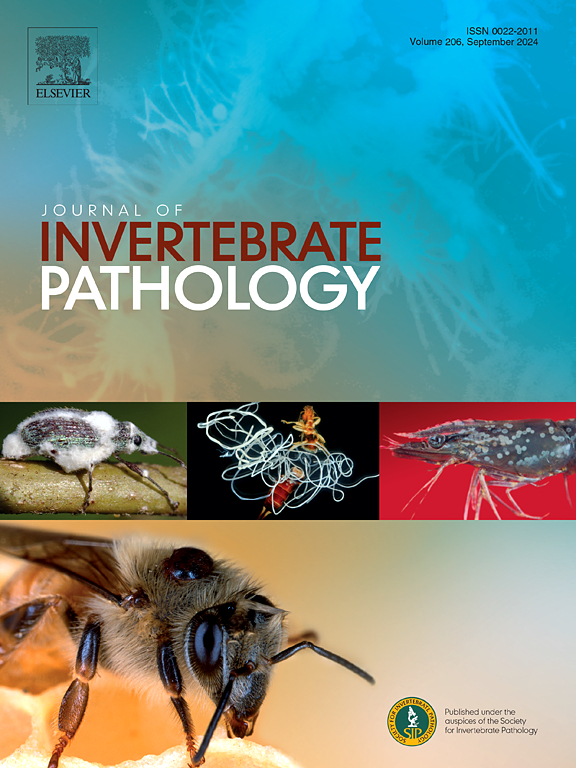The microspores of the parasitic dinoflagellate Hematodinium perezi infect crustacean hosts via waterborne transmission
IF 2.4
3区 生物学
Q1 ZOOLOGY
引用次数: 0
Abstract
The parasitic dinoflagellate in Hematodinium genus is an important pathogen of economically important wild and cultured marine crustaceans worldwide. Numerous studies have been conducted to investigate its epidemics, life cycle history, and transmission route. Recent in-field and lab studies have validated the effectiveness of the waterborne transmission route and hypothesized that dinospores are the key life stage to infect the crustacean hosts via waterborne transmission. However, until now, there is still no direct evidence to establish the infectious roles of Hematodinium dinospores for crustaceans via waterborne transmission. In the present study, Hematodinium microspores naturally released from Helice tientsinensis were used to immerse healthy juvenile Portunus trituberculatus with different development stages (C2–C4 instars, C6–C7 instars) and adult Helice tientsinensis, respectively. Hematodinium presence and prevalence in the two crustacean species were detected by hemolymph smear assay, H&E staining histopathology, and PCR analysis. The results showed that Hematodinium microspores successfully infected the two susceptible crustacean hosts, causing an overall Hematodinium prevalence of 40.4 % in P. trituberculatus (C2–C4 instars), 27.3 % in P. trituberculatus (C6–C7 instars), and 36.7 % in adult Helice tientsinensis, based on PCR analysis. The major findings in this study first provided direct and solid evidences to demonstrate that Hematodinium microspores are the key life stage to infect susceptible crustacean hosts via waterborne transmission. The physiological molting stage of crustacean hosts was found to be not associated with the infectious process of this parasite, while the growth stage of hosts was likely an important factor affecting the invasive and infectious process of Hematodinium microspores during waterborne transmission. The present study first established the waterborne transmission life stage of Hematodinium parasites, which will provide important information for effective prevention and control of Hematodinium epidemics in importantly economic marine crustaceans in future.

寄生鞭毛藻perezi的小孢子通过水传播感染甲壳类宿主
寄生鞭毛藻是世界范围内具有重要经济价值的野生和养殖海洋甲壳类动物的重要病原体。对其流行、生命周期历史和传播途径进行了大量研究。最近的现场和实验室研究证实了水生传播途径的有效性,并假设恐龙孢子是通过水生传播感染甲壳类宿主的关键生命阶段。然而,到目前为止,仍然没有直接的证据证明甲壳类动物通过水生传播的恐龙孢子嗜血杆菌的感染作用。本研究利用天津螺旋藻自然释放的血芽孢小孢子,分别浸泡不同发育阶段(C2-C4、C6-C7)的健康三管梭子鱼幼鱼和成虫。采用血淋巴涂片法、H&;E染色组织病理学和PCR分析检测两种甲壳类动物血液病的存在和流行情况。结果表明,两种易感甲壳类寄主均成功感染了血液病小孢子,导致三管圆虫(c2 ~ c4)、三管圆虫(c6 ~ c7)和成虫(36.7%)的总体血液病感染率分别为40.4%、27.3%和36.7%。本研究的主要发现首次提供了直接而坚实的证据,证明血液菌小孢子是通过水媒传播感染易感甲壳类宿主的关键生命阶段。研究发现,甲壳类寄主的生理蜕皮阶段与该寄生虫的感染过程无关,而寄主的生长阶段可能是影响血螨小孢子在水媒传播过程中侵入和感染过程的重要因素。本研究首次确定了吸血虫的水生传播生命阶段,为今后有效防控吸血虫在重要经济海洋甲壳类动物中的流行提供了重要信息。
本文章由计算机程序翻译,如有差异,请以英文原文为准。
求助全文
约1分钟内获得全文
求助全文
来源期刊
CiteScore
6.10
自引率
5.90%
发文量
94
审稿时长
1 months
期刊介绍:
The Journal of Invertebrate Pathology presents original research articles and notes on the induction and pathogenesis of diseases of invertebrates, including the suppression of diseases in beneficial species, and the use of diseases in controlling undesirable species. In addition, the journal publishes the results of physiological, morphological, genetic, immunological and ecological studies as related to the etiologic agents of diseases of invertebrates.
The Journal of Invertebrate Pathology is the adopted journal of the Society for Invertebrate Pathology, and is available to SIP members at a special reduced price.

 求助内容:
求助内容: 应助结果提醒方式:
应助结果提醒方式:


